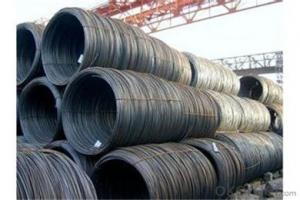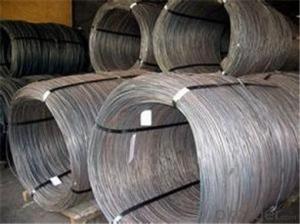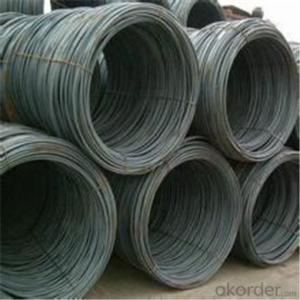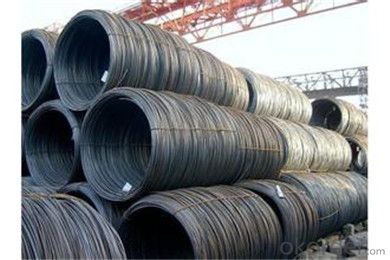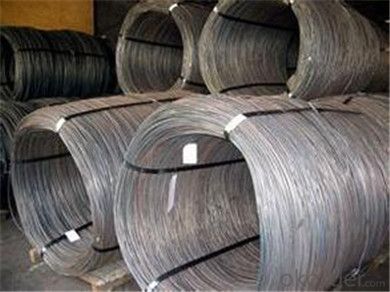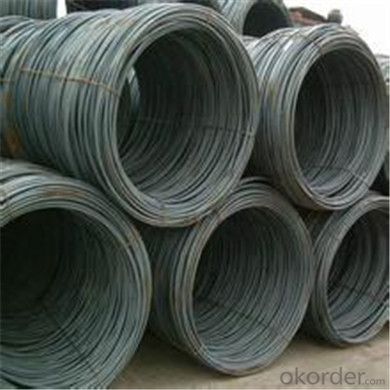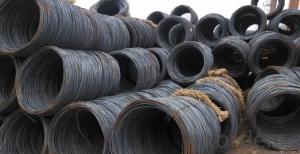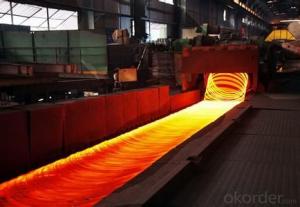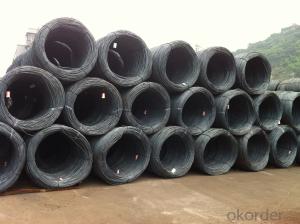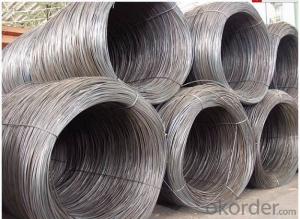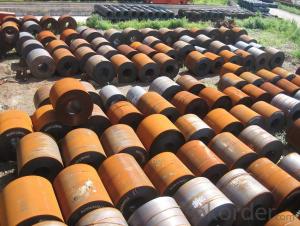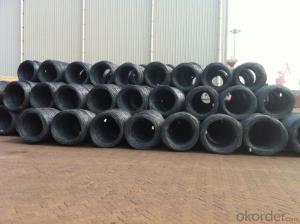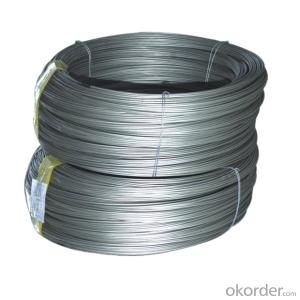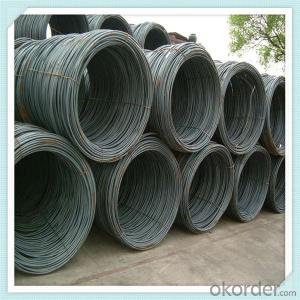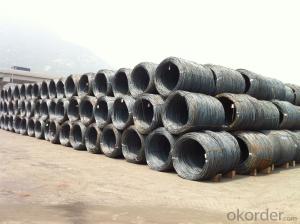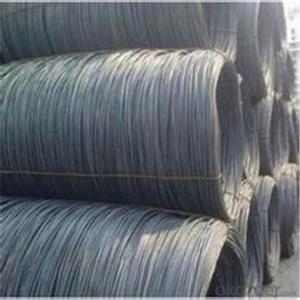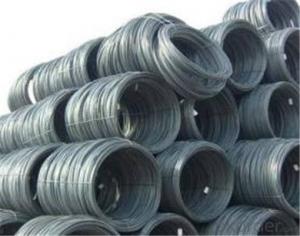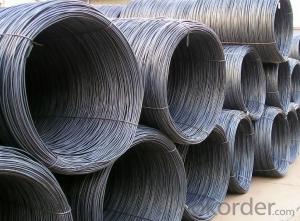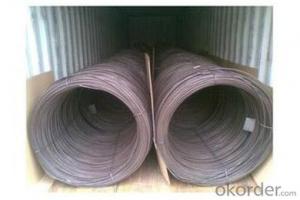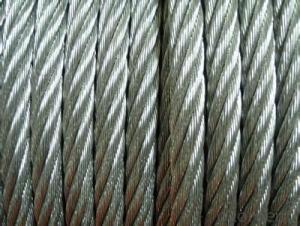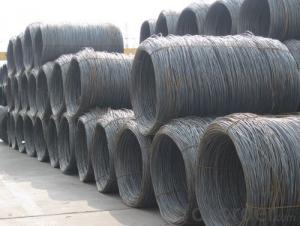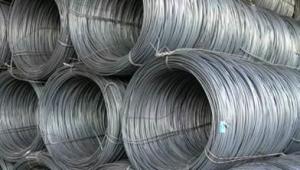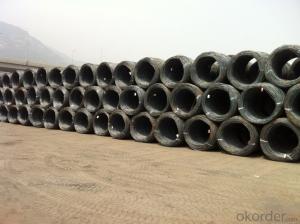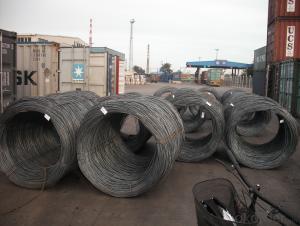SAE1008 Steel Wire rod 5.5mm with Best Quality
- Loading Port:
- Tianjin
- Payment Terms:
- TT OR LC
- Min Order Qty:
- 60 m.t.
- Supply Capability:
- 455566666 m.t./month
OKorder Service Pledge
OKorder Financial Service
You Might Also Like
Specification
Description of wire Rod:
wire rod:
Grade:SAE1006B/SAE1008B/SAE1018B
Size:5.5/6.5/7/8/9/10/11/12mm
Festures of wire Rod:
· fasteners, bolts, rivets, screws,
· general purpose wires,
· electrode wires, industrial wires, agriculture wires,
· bush wires, chain rivet wires,
· detonator wire,
· Umbrella ribs, upholstery wires, cycle spokes, needle wires, heald wires, staple pin Wire, safety pin wires
· ACSR wires, earth wires,
· tyre and hose reinforcement wires,
Specifications of wire Rod:
Grade | Chemical Composition(%) | |||||
C | Mn | Si | S | P | Cr | |
SAE1006B | 0.03~O.07 | ≤0.32 | ≤0.30 | ≤0.045 | ≤0.040 | 0.3-0.35 |
Mechanical properties | ||||||
Yield strength(N/mm2) | Tensile strength(N/mm2) | Elongation(%) | ||||
250-280 | 350-380 | ≥32 | ||||
Grade | Chemical Composition(%) | |||||
C | Mn | Si | S | P | Cr | |
SAE1008B | 0.10max | 0.3~O.50 | 0.15max | 0.050max | 0.040 max | 0.3-0.35 |
Mechanical properties | ||||||
Yield strength(N/mm2) | Tensile strength(N/mm2) | Elongation(%) | ||||
≥195 | 315-430 | ≥30 | ||||
Images of wire Rod:
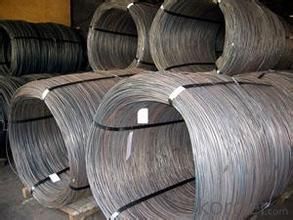
FAQ:
1. What is your package?
Packing situation: standard seaworthy packing or as customer required.
2. How long is the lead time?
Delivery time: 45 days after order confirmed.
3. What payment term do you accept?
Payment: T/T or L/C at sight.
- Q: How does the magnetic properties of steel wire rod vary with different grades?
- The magnetic properties of steel wire rod vary with different grades due to the varying composition and microstructure of the steel. High carbon steel wire rods, for example, have a lower magnetic permeability and are less magnetic compared to low carbon steel wire rods. Additionally, the presence of alloying elements such as nickel or chromium can affect the magnetic properties. In general, the higher the carbon content and the more alloying elements present, the lower the magnetic properties of the steel wire rod.
- Q: What are the major applications of low carbon steel wire rod?
- Low carbon steel wire rod has various major applications due to its versatility and characteristics. It is commonly used in the manufacturing of nails, screws, wire mesh, fencing, barbed wire, and other construction materials. Additionally, it is utilized in the production of automotive parts, such as springs and suspension components, as well as in the manufacturing of household appliances and electrical wires. Its affordability and strength make it a popular choice in numerous industries.
- Q: What are the main applications of steel wire rod in automotive manufacturing?
- Steel wire rod is widely used in automotive manufacturing for various applications. One of the main uses is in the production of tires, where steel wire rod is used as reinforcement material to enhance the strength and durability of tires. Steel wire rods are also used in the manufacturing of springs, such as suspension springs and seat springs, which provide stability and support to the vehicle. Additionally, steel wire rod is utilized in the production of automotive cables, such as brake cables and clutch cables, due to its high tensile strength and excellent resistance to corrosion. Overall, steel wire rod plays a crucial role in automotive manufacturing by providing essential components that ensure the safety, performance, and reliability of vehicles.
- Q: What are the different types of electrical cables made from steel wire rod?
- There are several different types of electrical cables that are made from steel wire rod. One common type is steel wire armored (SWA) cable, which is used for underground and outdoor installations. It consists of a steel wire armor layer that provides mechanical protection to the cable and allows it to withstand external stresses. Another type is steel tape armored (STA) cable, which also provides mechanical protection but uses a steel tape instead of a wire armor layer. This type of cable is often used in high voltage and industrial applications where extra protection is required. Steel wire braided (SWB) cable is another variation, which features a braided steel wire layer around the insulation. This design provides additional flexibility and resistance to external damage. Furthermore, steel wire reinforced (SWR) cable is used in applications where high tensile strength is required. It consists of a steel wire reinforcement layer that enhances the cable's ability to withstand pulling forces. Lastly, steel wire composite (SWC) cable is a type of cable that combines steel wire with other materials such as aluminum or copper. This combination allows for improved electrical conductivity while still maintaining the mechanical strength provided by the steel wire. Overall, these different types of electrical cables made from steel wire rod offer varying levels of mechanical protection, flexibility, and tensile strength, allowing for their use in a wide range of applications.
- Q: What are the common production processes for tungsten-coated steel wire rod?
- The common production processes for tungsten-coated steel wire rod typically include wire drawing, cleaning, coating, and heat treatment. Initially, the steel wire rod is drawn through a series of dies to reduce its diameter and improve its surface finish. After the wire drawing process, the wire rod is cleaned to remove any impurities. Then, a layer of tungsten is applied to the surface of the wire rod through various coating techniques such as electroplating or vapor deposition. Finally, the coated wire rod undergoes a heat treatment process to enhance the adhesion between the tungsten coating and the steel wire, resulting in a durable and high-quality product.
- Q: What are the various applications of steel wire rod?
- Steel wire rods have a wide range of applications across various industries. They are commonly used in the construction sector for reinforcing concrete structures such as buildings, bridges, and highways. Steel wire rods are also utilized in the manufacturing of automotive components, including springs, cables, and tires. Additionally, they find application in the production of wire mesh for fencing, as well as in the manufacturing of electrical wires and cables. Furthermore, steel wire rods are used in the production of various household items, such as kitchen utensils, furniture, and appliances.
- Q: How is steel wire rod used in the production of wire mesh?
- Steel wire rod is an essential component in the production of wire mesh. Wire mesh, also known as wire cloth or wire fabric, is a versatile material that is used in various industries for different purposes. The production of wire mesh begins with the manufacturing of steel wire rod. Steel wire rod is produced through a process called hot rolling, where molten steel is passed through a series of rollers to form a long, continuous rod with a specific diameter. The diameter of the steel wire rod can vary depending on the desired end product and application of the wire mesh. Once the steel wire rod is produced, it is then drawn through a series of dies to reduce its diameter further. Drawing the wire rod through these dies not only reduces its diameter but also improves its tensile strength and surface finish. This drawn wire is now ready to be used in the production of wire mesh. The steel wire rod is fed into a wire mesh machine, where it goes through a series of processes to form the wire mesh. The wire is first straightened and then cut into the desired length. These cut lengths of wire are then fed into a weaving machine, where they are interwoven to form the mesh pattern. The wire mesh machine uses various techniques to create different types of wire mesh, such as plain weave, twill weave, or Dutch weave. The steel wire rod acts as the building blocks for these patterns, providing the strength and durability needed for the wire mesh to withstand various applications. Once the wire mesh is woven, it undergoes further processes, such as galvanizing or coating, to enhance its properties. Galvanizing involves coating the wire mesh with a layer of zinc to protect it from corrosion, while coating can provide additional properties like resistance to heat, chemicals, or abrasion. In summary, steel wire rod is a crucial material in the production of wire mesh. It is used as the starting material, which is then processed and woven to create various types of wire mesh patterns. The steel wire rod provides the necessary strength and durability for the wire mesh to be used in different industries and applications.
- Q: How is the impact resistance of steel wire rod tested?
- The impact resistance of steel wire rod is typically tested using a Charpy impact test. In this test, a notched specimen of the wire rod is subjected to a swinging pendulum that strikes and breaks the specimen. The energy absorbed by the specimen during fracture is measured, which provides an indication of its impact resistance.
- Q: What are the common alloying elements in steel wire rod?
- The common alloying elements in steel wire rod are typically carbon, manganese, silicon, and sometimes small amounts of sulfur and phosphorous. These alloying elements are added to steel in order to enhance its mechanical properties and improve its performance in specific applications. Carbon is the primary alloying element in steel, as it increases hardness and strength. Manganese improves steel's strength and toughness, while silicon contributes to its strength and resistance to oxidation. Sulfur and phosphorous are typically present in very small amounts and are considered impurities, but can have a positive effect on machinability and free-cutting properties of the steel. It is important to note that the specific alloying elements and their proportions can vary depending on the desired properties and intended use of the steel wire rod.
- Q: Round steel. Wire rod. Is a high wire a kind of thing?
- Round bar, wire rod and wire rod are not the same thing. Refer to refer toRound steel (Rounds): bars of diameter greater than 8mmBars (Bar): straight bars with rounded sections, six angles, square shapes, or other special-shaped bars. In stainless steel, the majority of bars generally refer to round steel.
Send your message to us
SAE1008 Steel Wire rod 5.5mm with Best Quality
- Loading Port:
- Tianjin
- Payment Terms:
- TT OR LC
- Min Order Qty:
- 60 m.t.
- Supply Capability:
- 455566666 m.t./month
OKorder Service Pledge
OKorder Financial Service
Similar products
Hot products
Hot Searches
Related keywords
